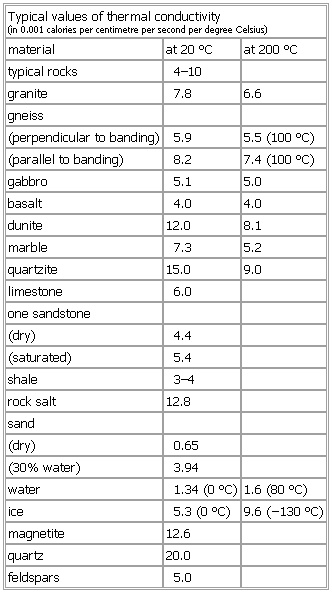Typical values of thermal conductivity
- Typical values of thermal conductivity
-
Typical values of thermal conductivity
(in 0.001 calories per centimetre per second per degree Celsius)
material at 20 °C at 200 °C
typical rocks 4–10
granite 7.8 6.6
gneiss
(perpendicular to banding) 5.9 5.5 (100 °C)
(parallel to banding) 8.2 7.4 (100 °C)
gabbro 5.1 5.0
basalt 4.0 4.0
dunite 12.0 8.1
marble 7.3 5.2
quartzite 15.0 9.0
limestone 6.0
one sandstone
shale 3–4
rock salt 12.8
sand
(30% water) 3.94
water 1.34 (0 °C) 1.6 (80 °C)
ice 5.3 (0 °C) 9.6 (−130 °C)
magnetite 12.6
quartz 20.0
feldspars 5.0
See as table:
* * *
Universalium.
2010.
Look at other dictionaries:
Thermal conductivity — In physics, thermal conductivity, k, is the property of a material that indicates its ability to conduct heat. It appears primarily in Fourier s Law for heat conduction.First, we define heat conduction by the formula::: H=frac{Delta Q}{Delta t}=k … Wikipedia
thermal conduction — Transfer of heat energy resulting from differences in temperature between adjacent bodies or adjacent parts of a body. In the absence of a heat pump, the energy will flow from a region of higher temperature to a region of lower temperature. The… … Universalium
Thermal management of high power LED — With the coming of energy saving era, high power light emitting diodes (LEDs) are promising to replace other technologies such as incandescent and fluorescent bulbs in signaling, solid state lighting, and vehicle headlight applications due to… … Wikipedia
Thermal copper pillar bump — The Thermal Copper Pillar Bump, also known as the thermal bump , is a thermoelectric device made from thin film thermoelectric material embedded in flip chip interconnects (in particular copper pillar solder bumps) for use in electronics and… … Wikipedia
Hydraulic conductivity — Hydraulic conductivity, symbolically represented as K, is a property of vascular plants, soil or rock, that describes the ease with which water can move through pore spaces or fractures. It depends on the intrinsic permeability of the material… … Wikipedia
Ocean thermal energy conversion — Temperature differences between the surface and 1000m depth in the oceans Ocean Thermal Energy Conversion (OTEC) uses the difference between cooler deep and warmer shallow or surface ocean waters to run a heat engine and produce useful work,… … Wikipedia
rock — rock1 rockless, adj. rocklike, adj. /rok/, n. 1. a large mass of stone forming a hill, cliff, promontory, or the like. 2. Geol. a. mineral matter of variable composition, consolidated or unconsolidated, assembled in masses or considerable… … Universalium
Rock — /rok/, n. a male given name. * * * I In geology, a naturally occurring and coherent aggregate of minerals. The three major classes of rock igneous, sedimentary, and metamorphic are based on the processes that formed them. These three classes are… … Universalium
Electrical resistivity and conductivity — This article is about electrical conductivity in general. For the specific conductance of aqueous solutions, see Conductivity (electrolytic). For other types of conductivity, see Conductivity. Electrical resistivity (also known as resistivity,… … Wikipedia
gas — gasless, adj. /gas/, n., pl. gases, v., gassed, gassing. n. 1. Physics. a substance possessing perfect molecular mobility and the property of indefinite expansion, as opposed to a solid or liquid. 2. any such fluid or mixture of fluids. 3. any… … Universalium

